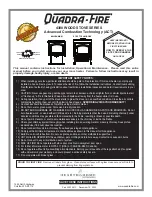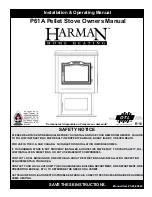
EN
33
Setting up the stove and connecting the chimney
The packaging of your new stove is designed to provide optimum protection from damages. It is, however, possible
that damage to the stove or the accessories may occur during transportation. Please check your stove after unpacking
for damages and to ensure that all the components are there! In the event of damage or missing items, immediately
inform your stove dealer!
Comment: Loose draught baffle plates or those that have slipped out of their anchorage or similar are not considered
faults (see Chapter
►
First use of your stove – p. 37).
The packaging of your stove is, for the most part, environmentally neutral. The wood of the packaging has not been
surface treated and can be cut up and used for heating purposes. The cardboard and the sheeting can easily be
recycled via community recycling centres.
With a stove with a self-closing firebox door, connection to a chimney already connected to other stoves and
fireplaces is possible, as long as the chimney dimension in accordance with DIN EN 13384 or 13384-2 does not
counteract this.
When operating multiple fireplaces in a single room or an air connection, ensure that the combustion air supply is
sufficient.
A steel plate flue should be used to connect to the chimney. The flue connection to both the flue gas socket and the
chimney must be securely made and well-sealed. This secure and sealed connection is absolutely essential when
connecting the flue elements to each other. It is essential to ensure that the flue does not extend into the free cross-
section of the chimney. We recommend using a masonry liner to introduce it into the chimney.
When using extended flue gas piping, horizontal paths and constrictions must be avoided. Piping that rises in the
direction of the chimney is recommended. In the event of a low chimney draught, we recommend connecting the
stove via a vertical pipe at least 1 m in length.
Generally speaking, when connecting flues, the legal regulations are to be maintained. When connecting to a
chimney above the upper flue connection, you should keep, for example, a distance of 40 cm from the flue to
flammable construction elements. This minimum distance may be reduced to 10 cm if the flue is fitted with a non-
flammable insulation at least 2 cm in thickness.
The correct connection of the flue is, in all instances, to be confirmed by the local chimney sweep or heating
professional.
Safety distances (minimum distances):
When setting up the chimney, the authority prescribed fire protection regulations should be observed on principle.
Consult your local chimney sweep or heating professional in this regard.
The minimum distance to flammable or temperature-sensitive materials (e.g. furniture, wallpaper, wood-cladding)
or to carrying walls must be maintained as follows.
The appropriate distances for your model can be found on the enclosed unit datasheet which is a component of these
operating instructions.
In the event of flammable or temperature-sensitive floor coverings, the device must be set-up on a non-flammable
floor protection plate (e.g. steel plate, glass). Floor protection plates (underlay plate or guard) can be purchased from
the accessories range carried by your dealer. If necessary, you can order these from your stove dealer.
The minimum dimensions/safety distances can be found on the device datasheets and inspection assessments
Operating the stove
The stove may only be heated by adults. Make sure that children are never left unattended with the stove (do not
leave the stove unattended over a longer period of time). The stove may only be used in accordance with these
















































